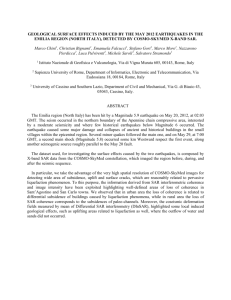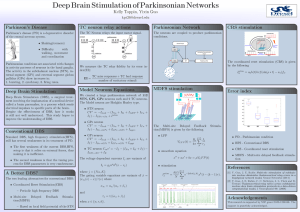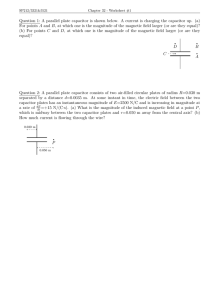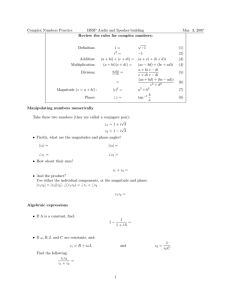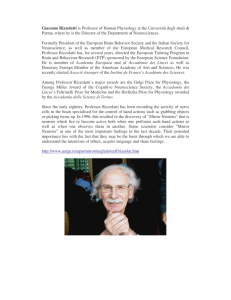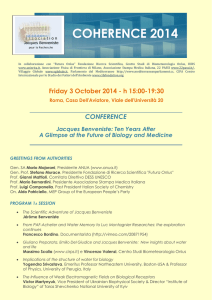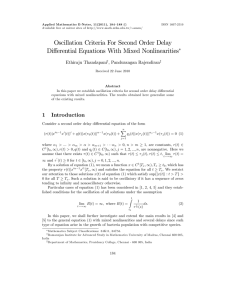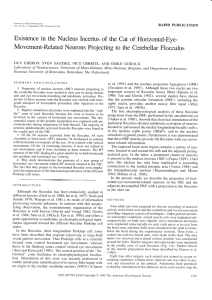Customization of coherence analysis by relaxing its iso-frequency constraint
advertisement
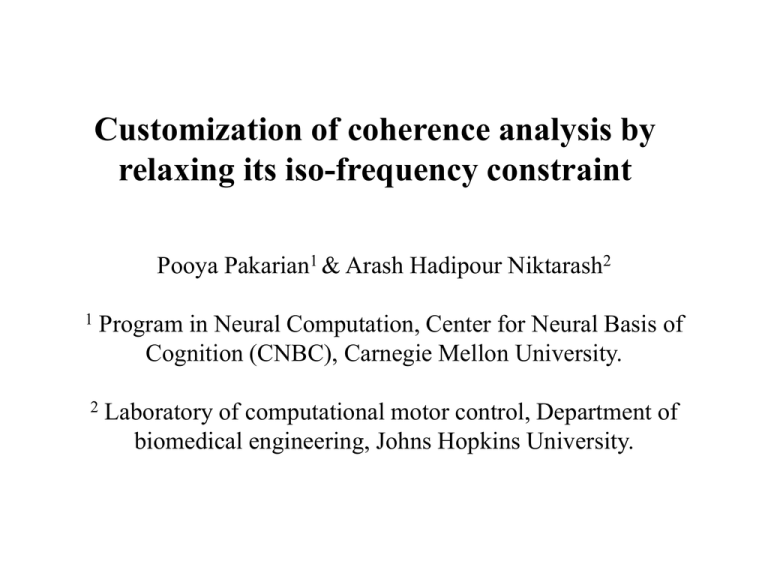
Customization of coherence analysis by relaxing its iso-frequency constraint Pooya Pakarian1 & Arash Hadipour Niktarash2 1 2 Program in Neural Computation, Center for Neural Basis of Cognition (CNBC), Carnegie Mellon University. Laboratory of computational motor control, Department of biomedical engineering, Johns Hopkins University. Magnitude Cross Correlation: dot product of complex numbers (sizes multiplied, angles subtracted because the second one is conjugated) Sum of the vectors, depends not only on the size of the vectors, but also on the angles: consistency of phase difference between the two original waves The size of this vector represents the magnitude cross correlation between signals x and Y: = MCCxy Magnitude Auto Correlation: The magnitude of each frequency (f=3 cycles per window) over n windows (n=2 in this example) represents a vector in an n dimensional space. The size of this vector represents the magnitude auto correlation of signal x: MACx The size of this vector represents the magnitude auto correlation of signal Y: MACy Magnitude Squared Coherence: (MCCxy)2 (MACx)(MACy) Coherence is calculated between identical frequencies (shown as f ) of the two signals (x and y), therefore can not probe the relation between different frequencies of the two signals; for example those described in: *Liu et al (2002): High frequency (100 Hz) electrical stimulation of the subthalamic nucleus (STN) induced tremor (4 Hz) in both forearms, and also oscillation of the contralateral STN (4 Hz). In contrast, low frequency (5 Hz) stimulation induced contralateral arrhythmic involuntary movement (3 Hz). *Paré et al (1990): 100-400 Hz activity in thalamic neurons related to Parkinson’s tremor (3-8 Hz). *Brown et al (2004) Exp Neurol: 10 Hz stimulation of Sunbthalamic Area, potentiates 31-40 Hz oscillation in GPi. Relaxing the iso-frequency constraint: Let’s calculate the coherence for all pairs of frequencies of the two signals, not only for identical frequencies, therefore the functional relation of them can be shown even in different frequencies. For example: Hadipour-Niktarash A. (2006) J Comput Neurosci. The simulation results show that, by an interaction between the TC and RE neurons, the TC-RE network transforms a low-frequency oscillatory activity of the GPi neurons to a higher frequency of oscillatory activity of the TC neurons. (superharmonic transformation) (TC= thalamic cell; RE= reticular nucleus; GPi= Globus Pallidus ) GPi TC TC oscillation frequency 4 Hz simulated GPi burst can trigger 8 HzTC burst. GPi oscillation frequency Future plan: Wavelet-base coherence analysis Harmonic frequencies that pertain to the non-sinusoidal shape of a signal can induce false-positive high non-linear coherence. They can be removed by calculating this customized coherence based on the appropriate wavelet analysis, instead of Fourier analysis whose base is sinusoidal wave. Acknowledgement: We thank Dr. William MacKay of the University of Toronto for insightful comments. References: Liu X, Ford-Dunn HL, Hayward GN, Nandi D, Miall RC, Aziz TZ, Stein JF. (2002) The oscillatory activity in the Parkinsonian subthalamic nucleus investigated using the macro-electrodes for deep brain stimulation. Clin Neurophysiol. 113(11):1667-72. Paré D, Curro'Dossi R, Steriade M. (1990) Neuronal basis of the parkinsonian resting tremor: a hypothesis and its implications for treatment. Neuroscience. 35(2):217-26. Brown P, Mazzone P, Oliviero A, Altibrandi MG, Pilato F, Tonali PA, Di Lazzaro V. (2004) Effects of stimulation of the subthalamic area on oscillatory pallidal activity in Parkinson's disease. Exp Neurol. 188(2):480-90. Hadipour-Niktarash A. (2006) A computational model of how an interaction between the thalamocortical and thalamic reticular neurons transforms the lowfrequency oscillations of the globus pallidus. J Comput Neurosci. 20(3):299-320.
